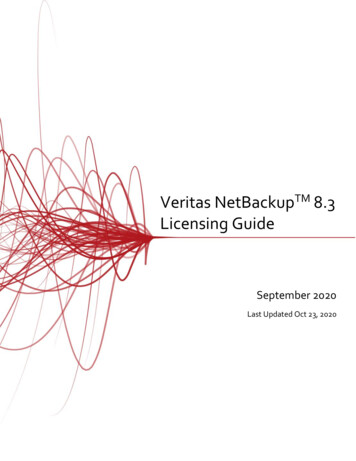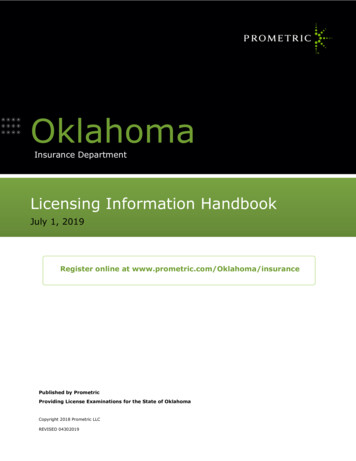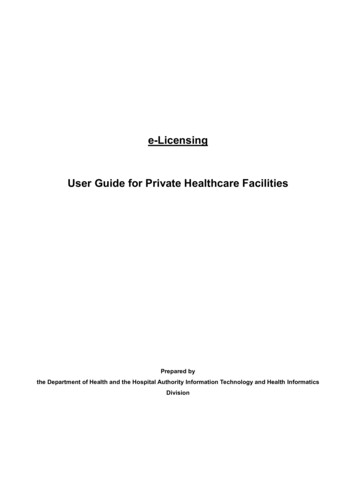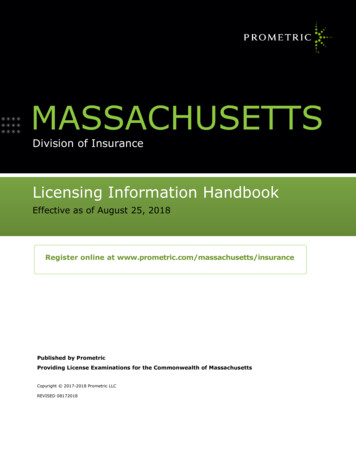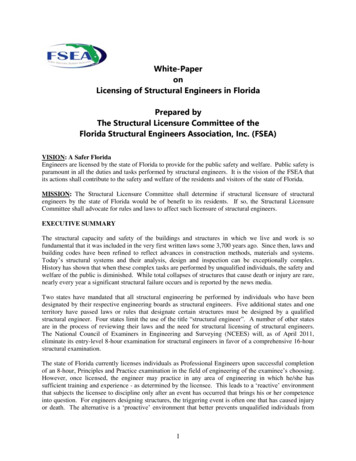
Transcription
White-PaperonLicensing of Structural Engineers in FloridaPrepared byThe Structural Licensure Committee of theFlorida Structural Engineers Association, Inc. (FSEA)VISION: A Safer FloridaEngineers are licensed by the state of Florida to provide for the public safety and welfare. Public safety isparamount in all the duties and tasks performed by structural engineers. It is the vision of the FSEA thatits actions shall contribute to the safety and welfare of the residents and visitors of the state of Florida.MISSION: The Structural Licensure Committee shall determine if structural licensure of structuralengineers by the state of Florida would be of benefit to its residents. If so, the Structural LicensureCommittee shall advocate for rules and laws to affect such licensure of structural engineers.EXECUTIVE SUMMARYThe structural capacity and safety of the buildings and structures in which we live and work is sofundamental that it was included in the very first written laws some 3,700 years ago. Since then, laws andbuilding codes have been refined to reflect advances in construction methods, materials and systems.Today’s structural systems and their analysis, design and inspection can be exceptionally complex.History has shown that when these complex tasks are performed by unqualified individuals, the safety andwelfare of the public is diminished. While total collapses of structures that cause death or injury are rare,nearly every year a significant structural failure occurs and is reported by the news media.Two states have mandated that all structural engineering be performed by individuals who have beendesignated by their respective engineering boards as structural engineers. Five additional states and oneterritory have passed laws or rules that designate certain structures must be designed by a qualifiedstructural engineer. Four states limit the use of the title “structural engineer”. A number of other statesare in the process of reviewing their laws and the need for structural licensing of structural engineers.The National Council of Examiners in Engineering and Surveying (NCEES) will, as of April 2011,eliminate its entry-level 8-hour examination for structural engineers in favor of a comprehensive 16-hourstructural examination.The state of Florida currently licenses individuals as Professional Engineers upon successful completionof an 8-hour, Principles and Practice examination in the field of engineering of the examinee’s choosing.However, once licensed, the engineer may practice in any area of engineering in which he/she hassufficient training and experience - as determined by the licensee. This leads to a ‘reactive’ environmentthat subjects the licensee to discipline only after an event has occurred that brings his or her competenceinto question. For engineers designing structures, the triggering event is often one that has caused injuryor death. The alternative is a ‘proactive’ environment that better prevents unqualified individuals from1
practicing structural engineering. This paper discusses the issues regarding structural licensing forstructural engineers (SEs) in Florida.BACKGROUND & HISTORY OF STRUCTURAL ENGINEERING LICENSING IN U.S.The Code of Hammurabi, written around 1762 BC, includes three laws relating to the strength ofstructures, including: “If a builder builds a house for a man and does not make its construction firm, andthe house which he has built collapses and causes the death of the owner of the house, that builder shallbe put to death”. Over the ensuing 3,700 years, our laws have been refined to reflect our changingattitudes toward the death penalty, and building codes have been revised to reflect the advances inmaterials, components and methods of design and construction.Prior to the year 2000, the criterion for the design of buildings and structures in Florida was largelyestablished by local ordinances and laws. Most of those laws and ordinances referred to generallyaccepted national codes which often contained very few pages dedicated to structural design. The current(2010) Florida Building Code includes over 230 pages related to structural strength, reliability anddurability. Each new generation of engineering methods and techniques of analysis brings with itcorresponding increases in complexity and sophistication. Prior to the 1960s, structural codes generallyspecified a safety factor selected by the judgment of the code writers. But with more detailedunderstanding of how structures react to real conditions, structural codes are now based on probabilisticanalysis. While this leads to more efficient use of materials and reduced construction costs, it requires ahigher level of understanding, knowledge, training and experience with these complex structural systems.Structural licensing of structural engineers goes back as far as 1915 in the United States. The state ofIllinois was the first to enact a SE licensing act. In November 2000, the three major national structuralengineering organizations - the Council of American Structural Engineers (CASE), the National Councilof Structural Engineers Associations (NCSEA), and the Structural Engineering Institute (SEI) of theAmerican Society of Civil Engineers (ASCE) - held a national summit on structural licensing of structuralengineers. The attendees concluded that the field of structural engineering is changing rapidly, and thestructures that SE’s design are important and often critical. Therefore, those practicing structuralengineering should have appropriate credentials, stay current in the field, and demonstrate soundjudgment that comes only with experience. As a result, all three of these organizations have now endorsedstructural licensing for structural engineers.Currently, fifteen states and one territory have some form of SE licensing: Alaska, Arizona, California,Guam, Hawaii, Idaho, Illinois, Louisiana, Massachusetts, Nebraska, Nevada, New Mexico, Oregon, Utah,Vermont and Washington. The requirements vary as to the amount and type of experience requiredbeyond the normal PE license, and the examinations that must be passed to obtain licensure. There aredifferences in the type of licensure from state to state. They include: full practice restriction, partialpractice restriction, partial practice rules, title statutes, and title rules.The type of structures required to be designed by a SE also varies from state to state. The type ofstructure ranges from “all” structures to those based upon design criteria factors such as height, area,category of the structure, span (if a bridge) and number of occupants.EXAMPLES OF SIGNIFICANT STRUCTURAL FAILURES IN FLORIDAHarbour Cay Condominium, Cocoa Beach, Florida2
The Harbour Cay Condominium, a five-story flat-plate reinforced concrete building underconstruction, collapsed shortly after 3 pm on March 27, 1981, killing 11 workers and injuringanother 23. The collapse occurred during placement of the roof slab. The most probable cause ofcollapse was a combination of design and construction errors: the design did not consider thepossibility of punching shear failure and therefore specified a slab thickness of 8 inches when 11inches was required; top reinforcing steel in the slab at the column was placed lower than specifiedfurther reducing the punching shear resistance. While the slab thickness was less than the buildingcode specified, the slab thickness and reinforcement placement specified in the structural drawingswould have provided sufficient punching shear resistance to withstand the construction loads.However, the reinforcement shop drawings called for bar support chairs that placed the reinforcingbars incorrectly.Turner Agricultural Center, Arcadia, FloridaBuilt in 2002 and certified by the Architect of Record that it was designed for 140 MPH winds; theTurner Agricultural Center was used as a hurricane shelter for the Hurricane Charley event ofFriday, August 13, 2004. Approximately 1,400 people were housed in the facility as the stormapproached. One of those individuals reported “The mood was cheerful, almost like the gatheringbefore a concert. As the winds started getting stronger, the noise inside got louder. We startednoticing a panel of roofing at the far end of the building starting to lift, much like a tarp not tieddown tight enough. It started to lift higher and higher, and an announcement came to get to theopposite end of the building. We did so, and shortly thereafter, the far end of the roof started to blowoff. Bits of paneling and insulation were swirling around the building. Many people started runningout of the building into the storm. Next we heard a wrenching sound and saw that the roof wascoming down. We headed down a concrete corridor which dead-ended into a dressing room. Wespent the next half-hour or so, standing in a layer of water with 20-30 other people waiting. It wasthe most terrifying incident of my life.” One FEMA report indicated that clips holding the roofpanels to the steel supports failed resulting in portions of the roof blowing off. The project is still inlitigation.Berkman Plaza II Parking Garage, Jacksonville, FloridaJacksonville-based A.A. Pittman & Sons Concrete Co. had been pouring the top level of a six-story,post-tensioned concrete garage for about four hours when it collapsed at about 6 a.m. on December6, 2007. Jacksonville Fire and Rescue Department responders found 60% of the structurecollapsed, like a stack of pancakes. According to the state’s lead structure specialist on the rescueteam, the remaining 40% was standing, but badly damaged. The collapse resulted in the death ofone construction worker and injured 23 others. After several investigations by both private andgovernmental firms, the September issue of Engineering News Record reports “Design deficienciesdraw the most fire in the government engineer’s report on the December 2007 fatal collapse of aparking garage under construction in Jacksonville, Fla.” The project is still in litigation.Sea Base Boy Scout Camp, Islamorada, FloridaOn February 2, 1988 this 6,000 square foot dormitory addition collapsed during construction. Thecontractor was in the process of placing thin lightweight concrete topping on an elevated concreteplank floor system. The plank system was supported by a new steel beam and column system whichlocated the concrete floor planks over and above, but not connected to, an existing masonrystructure. The entire addition, including architecture, structural, mechanical, electrical andplumbing, was designed by an architect who purported that he was experienced in structural designand had designed more than 300 structures. Multiple analyses of the structural design revealednumerous substantial defects. In particular, the steel columns were incapable of carrying the self-3
weight of the intended construction, and there was no provision for lateral restraint. The result ofthis architect’s design was a structure doomed to failure. No one was injured by this collapse, butsubstantial damage and expense was incurred. In hindsight, the timing of this collapse (duringconstruction) was fortuitous when compared to the alternative of construction having beencompleted, the building occupied and then collapsing causing injury and death.FLORIDA’S THRESHOLD LAWFollowing the collapses, failures, deaths and injuries of the 1970's and 1980's, particularly the HarbourCay Condominium incident, the Florida legislature recognized that the safety and welfare of the residentsof Florida would be improved if certain structures were inspected during construction by certified SpecialInspectors. The result was Florida Statute 553.79 which provides that the Board of Architecture and theBoard of Engineering certify individuals as Special Inspectors. The “threshold” requiring SpecialInspectors is buildings over three stories or 50 feet in height, buildings with an Assembly Occupancyexceeding 5000 square feet or an occupancy of more than 500 persons. Only those individuals withexperience in design and construction of buildings of these specific types and sizes of buildings may belicensed as Special Inspectors. The statute’s sole provision is to mitigate disparities between thestructural design as developed by the Architect or Engineer of Record and the actual construction. It doesnot address or provide for review of the sufficiency of the Architect’s or Engineer’s structural design.NCEES 16-HOUR STRUCTURAL EXAMThe current 16-hour exam for structural engineering went into effect in 2011. This exam consists of two8-hour components. The Vertical Force component focuses on gravity loads and incidental lateral loads.The Lateral Force component focuses on high wind and earthquake loads. Each component has a breadthmodule covering a comprehensive range of questions and a depth module focusing on a single area ofpractice. The breadth module questions are multiple choice. The depth module questions are essay. Thedepth module choices are buildings or bridges. Depth module choice must be consistent for bothcomponents. Each component must be passed to obtain licensure, however, not necessarily in the sametwo-day period.The areas to be tested are quite extensive. It is a challenging test that separates those practicing structuralengineering occasionally from those practicing it full-time.REASONS FOR STRUCTURAL LICENSING1. To protect the health, safety, and welfare of the public. The practice of structural engineering hasbecome an extremely complex profession, and only those fully qualified by appropriateeducation, experience, examination and licensure should be authorized to design structures.2. To reduce the number of unqualified engineers who design structures which require complicatedanalysis. We will never be able to stop the unscrupulous - those who knowingly and willinglypractice outside their area of expertise. What we can do is help ensure that those licensed topractice structural engineering have the knowledge and understanding to translate academictheory into practice, and that they do so on a regular basis. We are attempting to guard againstthose professionals who, though knowledgeable, have not kept up with ever-changing codes,4
specifications, and guidelines that govern the practice of structural engineering. Above all else,we are attempting to avoid costly failures and injury.3. To improve the structural design of more complex structures. As all engineers can attest, thepractice of structural engineering has become much more complex. Buildings and bridges are nolonger simple structures with regular grids or straightforward spans. More often than not, we areasked to span extreme distances, provide complex load transfers, and appear to defy the laws ofphysics.4. To improve structural design in our fast paced, design fee constrained environment. We are facedwith the challenges of "less" as well as less time, less budget, and less training. In this day andage of instant connections, fast downloads, and interconnectivity, we are expected to provideresults far more rapidly than ever before. In order to meet schedules and save the owner money,project delivery methods have changed from the old standard of design-bid-build to the moretime-saving methods of design-build, phased construction, fast-track, and integrated design.Budgets are often tight, and our advanced technology requires that we be ever more diligent insizing the structural elements and connections. Changes and advances in computer software haveallowed structural engineers to go farther than ever before, but we are often faced with the need to"get up to speed" on the latest and greatest systems in a hurry, so that we can include them in ourdesigns.5. To improve structural performance when subjected to extreme load conditions. Structuralengineers are also faced with the added challenge of designing structures with increasedexpectations of performance. Not only are buildings and bridges supposed to remain standingafter being subjected to extreme forces such as hurricanes, earthquakes, and severe storms; oftenthey are required to remain serviceable. Many must protect against disproportionate orprogressive collapse and blast effects. Still others must meet extreme limitations on vibration,deflection, and sway in addition to meeting the tight budget, aggressive schedule, and highstandards of quality for the project.6. To improve portability of registrations across various jurisdictions. Revising the licensing lawsand regulations for structural engineers in various jurisdictions will bring some added benefits. Ifrequirements for licensing are similar from state to state, it will be easier for engineers to obtainlicenses in numerous states so that they can adequately serve their clients. It is not uncommon forengineers to have clients in multiple states, or single clients who have projects across the country.Regulating the practice of structural engineering in all jurisdictions helps reduce confusion forbuilding officials and the public about who is qualified to design structures. It also helps guardagainst professionals practicing outside their area of expertise, and could aid in reducingdiscipline cases by state licensing boards.7. To improve design quality recognized by building officials. This will benefit both the designersand building officials by improving their comfort level knowing they are dealing with structuraldesign professionals.8. To clarify to the public the importance of structural design which is often taken for granted.5
9. To reduce insurance costs to individuals, businesses and government agencies.MODEL LAW STRUCTURAL ENGINEER/SECB CERTIFICATION VERSUS STRUCTURALLICENSURENCEES added a definition for a Model Law Structural Engineer (MLSE) to its Model Law in 2003 and itsCouncil Records Program in 2005. Separately, the Member Organizations of NCSEA voted in 2003 toestablish an independent body, the Structural Engineering Certification Board (SECB), to administer anational board certification program for structural engineers. The MLSE and SECB criteria are intendedeventually to serve as the basis for national uniformity in the qualifications required for SE licensure.SECB is intended to certify PEs and SEs who have comprehensive structural engineering education andexperience in structural engineering in the interest of safeguarding the health, safety and welfare of thepublic. The SECB certificate is not a license to practice structural engineering; it is just a namerecognition or roster designation. The SE license, on the other hand, is the privilege given by ajurisdiction to practice the discipline of structural engineering and is granted to individuals whodemonstrate minimum competence through education, experience, and examination.COMPARISON OF LAWS IN OTHER STATESSixteen states and one territory currently have specific provisions in place that distinguish structuralengineers from professional engineers in other disciplines. However, there is considerable variationamong these jurisdictions in the qualifications that are required for SE licensure. There are also importantdifferences in the significance of SE licensure within each jurisdiction. This inhibits the mobility of thosewho already have the SE license in one state and seek to obtain it in another.Only Illinois and Hawaii do not require candidates to be PEs in order to be SEs, since they have fullpractice SE acts. The idea of "separating" SEs from PEs comes from the fact that civil engineering is abroad field that covers many disciplines, including structural, but the depth and complexity required forpracticing structural engineering is not addressed in the civil PE exam. This is why a separate exam hasbeen developed to cover with reasonable breath and depth of issues required for an individual to provetheir competency as a licensed structural engineer.PRACTICE RESTRICTIONS AND TITLE RESTRICTIONSA practice restriction defines the specific type of work that a licensed engineer in a particular disciplinecan legally perform, along with the corresponding responsibilities and liabilities. The practice restrictioncan stand alone, which means other professional licensure is not required.A title restriction defines a general term that a licensed engineer is permitted to use for identifying his orher discipline.STATES WITH STRUCTURAL TITLE RESTRICTIONS6
AlaskaArizonaMassachusetts NebraskaVermontIdahoNevadaLouisianaNew MexicoSTATES WITH STRUCTURAL PRACTICE regon*Washington*Utah**with some exemptionsTRANSITIONINGUtah has recently passed a structural engineering partial practice restriction which includes a transitionclause. This clause was significant in the efforts to secure passage of the legislation. The legislationstates that an engineer must meet the requirements for structural engineering licensure by examination“except that prior to January 1, 2016, an applicant for licensure may submit a signed affidavit in a formprescribed by the division stating that the applicant is currently engaged in the practice of structuralengineering.” The legislation demonstrated the desire to “protect the public” by assuring that only thosequalified individuals become structural engineers. The legislation also desired to transition thoseengineers currently practicing in the field of structural engineering by having a liberal enough transitionprocedure to minimize the impact on those same engineers. Transition clauses were also included in thepartial practice restrictions recently passed by the states of Oregon and Washington.CONCLUSIONSIt is the conclusion of this committee that structural licensure of structural engineers in the state of Floridais beneficial to the public as a whole and to the profession. It is further concluded that Florida is a statewith challenging wind loading which requires a higher level of expertise that would be best assured by theenactment of a structural engineering licensure act. The Committee also concludes it is our obligation asstructural engineers to “raise the bar” by requiring structural licensure to better protect the public andimprove the quality of all structural engineering work.RECOMMENDATIONSIt is the recommendation of this committee that legislation be prepared and submitted to the statelegislative body to implement the enactment of appropriate amendments to the current Florida engineerlicense law to establish structural licensing for structural engineers. It is further recommended thatassociative professional associations be enlisted to aide in the success of this endeavor and to gain theirinsight in relation to and their support of this issue. It is further recommended that such actions be takenas soon as practically possible to better protect the life, safety and welfare of the public in the state ofFlorida.7
structural design as developed by the Architect or Engineer of Record and the actual construction. It does not address or provide for review of the sufficiency of the Architect's or Engineer's structural design. NCEES 16-HOUR STRUCTURAL EXAM The current 16-hour exam for structural engineering went into effect in 2011. This exam consists of two




